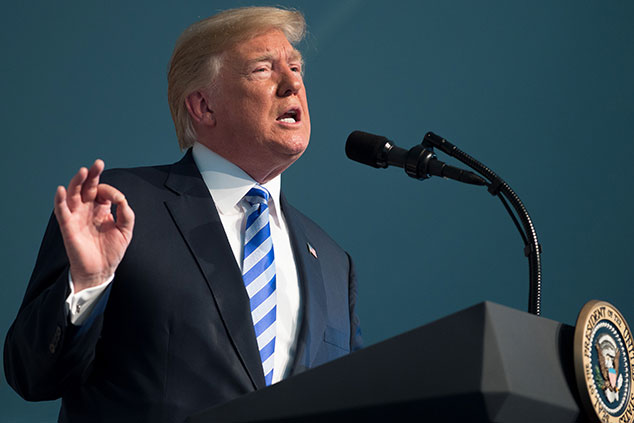
This article is taken from our FREE daily investment email Money Morning.
Every day, MoneyWeek’s executive editor John Stepek and guest contributors explain how current economic and political developments are affecting the markets and your wealth, and give you pointers on how you can profit.
.
In this week’s issue of MoneyWeek magazine
●
How to profit as the world gets fuller, richer and older
●
The top contrarian bets for your money today
●
Three small-cap stocks to shield you from the worst of the market’s ups and downs
●
Value investing vs momentum investing: watch out for the market’s mood swings
●
Energy fund experts have failed investors – look elsewhere
● Share tips of the week
Not a subscriber? Sign up here
Investors sent share prices higher yesterday.
Strong US employment data at the end of last week boosted spirits. On top of that, everyone is still basking in relief that Italy has stepped back from triggering another eurozone crisis for the time being.
Trouble is, there’s another, potentially bigger problem on the horizon – a global trade war is brewing.
Markets should take Trump at his word
For now, markets aren’t paying much attention to the idea of global trade war.
I have a horrible feeling that this is mainly because they aren’t taking the idea very seriously. Markets have grown very complacent on any number of levels in recent years – cheap debt has encouraged investors to believe that there’s no problem that cannot be solved by central bank intervention, for example.
But complacency over the logic of global trade goes back much longer than that. Investors believed that this argument was settled. Global trade has seemed like a win-win deal for so long, that they still can’t wrap their heads around the idea that anyone might really be questioning it.
What possible benefit could there be? Why would anyone do such a thing?
As for Donald Trump – well, the US president has a habit of shooting his mouth off. It might have seemed weird to announce policy via Twitter in the old days, but now it’s water off a duck’s back. These days, investors appear to be treating the president like a shouty, mildly deranged uncle at a family wedding. “Ignore uncle Don. A couple of sherries and he’ll crash out in the corner.”
The danger is that they might be heading for a nasty wake-up call. When it comes to statements of intent – rather than statements of fact – Trump appears to be a man of his word.
When he talks about protectionism and trade wars being good, he means it. People don’t believe him because it’s so at odds with the prevailing orthodoxy. But his actions so far all suggest that he’s entirely confident of his position.
The return of protectionism
So far, the main target of Trump’s tariffs has been the steel business. The US has imposed a 25% tariff on steel imports (and 10% on aluminium). These tariffs already applied to China, but Europe, Mexico and Canada had been temporarily excluded. That exclusion ended on Friday, and the US decided to go ahead and impose the taxes.
Now, by itself, steel tariffs are not necessarily a huge issue. They represent some grit in the wheels, but they’re not single-handedly sufficient to derail the global economy by any means.
The problem is: what happens next?
As Capital Economics puts it, while Trump’s current hardline stance might be seen as a starting point for further talks, “the risk of a trade war is greater now than it has been for many years. So at the very least, the risk ought to continue to curb investors’ enthusiasm for equities.”
What could make this escalate? As Bloomberg reports, ING analysts Viraj Patel and Raoul Leering reckon that Trump “would have to broaden protectionist measures to other sectors”. That’s by no means out of the question. Secondly, they say, you’d need to have tit-for-tat retaliation. Again, that’s hardly “out there” – in fact, it’s almost certain to happen.
Already the EU has drawn up a target list of 100 US goods for retaliatory tariffs, including bourbon and Florida orange juice, reports the BBC. Meanwhile, Mexico plans to tax imports of US pork.
It’s interesting, because following the early days of the financial crisis, growing protectionism was the one threat that everyone feared. It didn’t materialise back then – not nakedly, at least.
Central banks instead conducted a form of clandestine trade war by weakening their currencies in turns, but it was rather a civilised affair. It enabled everyone to pretend that they were playing nicely, and in the end, everyone got a turn.
But that’s not what’s happening now. Now we’ve got the delayed reaction, which is a result partly of frustration with the system that allowed 2008 to happen; and also with governments for delegating so much responsibility to central banks for dealing with it.
And this affection for protectionism might spread by other channels too. It’s not just about tit for tat. The US steel industry is pretty happy about these tariffs. There are plenty of other interest groups who might be emboldened to lobby for such measures around the world. And those policies might appeal to resurgent populists in many other countries.
It’s hard to spin this as anything other than negative for the global economy. Also, all else being equal, it’s inflationary. My colleague Matthew Partridge – conveniently enough – has just written a cover story for MoneyWeek on what returning inflation might mean for your portfolio. If you’re not already a subscriber, Sign up here.